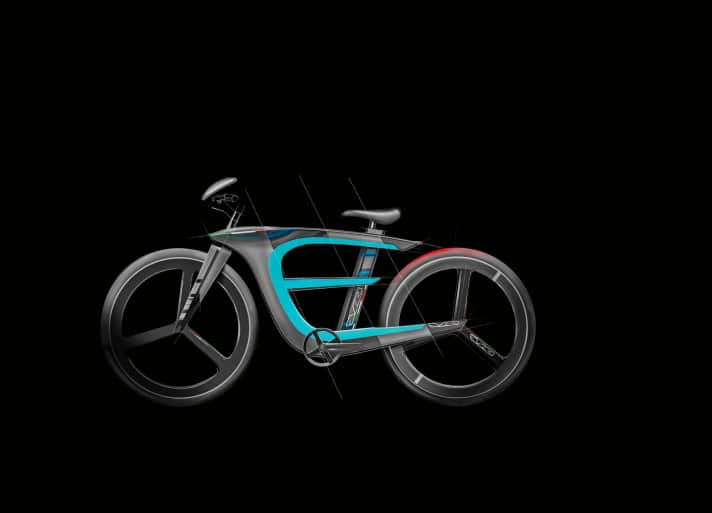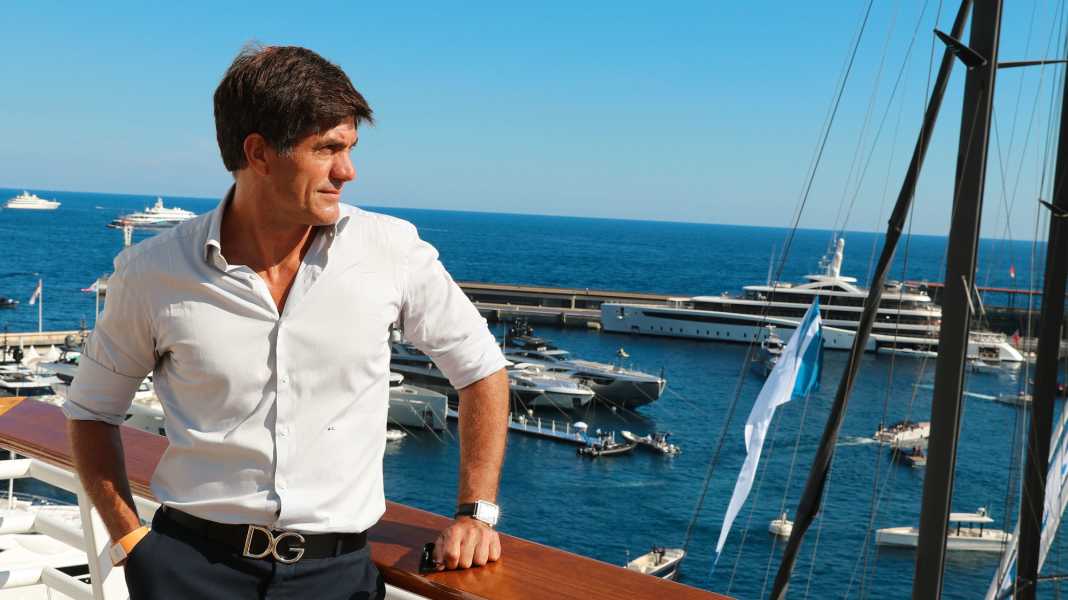
The smile is winning, the shoulders are broad and the Dolce & Gabbana belt buckle sits beneath a white monogrammed shirt with his initials to the left of the fifth button. Marco Casali is easy to spot amidst the hustle and bustle of the trade fair. Finding the CrossFit fanatic not in a good mood and bursting with energy is as rare as seeing an Itama in displacement mode. The Roman and his Studio Too Design probably offer the broadest design spectrum in the industry; current projects range between five and 50 metres, but he has already been involved in buildings up to 110 metres long.
Hardly any other designer navigates so stylishly between the world of yachts and boats and does not even shy away from the niche. "Giorgetto Giugiaro has designed many important sports cars, but his Fiat Panda has sold the most," says Casali, alluding to his motorboat designs for Bavaria. Since 2010, eight creations ranging from 35 to 45 feet have been commissioned by the shipyard in Giebelstadt. Above all, however, he has designed Itama's iconic power formats since 2004 and most recently ISA's super glider "Aldabra" ( click here for the portrait ). Two 50-metre formats under construction at Rossinavi and Columbus should not be forgotten. He recently surprised everyone with two Solarkat designs for Silent Yachts, a futuristic e-bike and two NFT yachts. He himself drives a Tesla X, which he parks in front of Too Design's headquarters, a terracotta-coloured villa rustica not far from the Italian capital.
Marco Casali was already drawing boats as a child
Marco Casali is the son of an Italian father and a Danish actress - "not blonde", as he emphasises. Yachting came early in his life. "When I was six years old, my parents bought a steel cruiser, an Akerboom. Top speed: eight knots - with a tailwind and stern sea," laughs Casali. The family lived in Rome, but the boat was based in Tuscany and they usually travelled to Sardinia. His father would sail around the harbours with him and present all the boats. Little Marco then drew them when they were at home and his mother fortunately kept the sketches. The early Casali liked it edgy and was already a friend of clear lines.
When he began his five-year architecture degree in Rome, boats did not initially play a role in his choice of subject. "Designing boats was my passion, but I never thought it could become a job." Until he met Gianni Zuccon. Zuccon, who together with Pierluigi Spadolini is considered one of the founding fathers of the Italian yacht design guild, also worked as a professor and supervised Casali's graduation project in 1999: a 120-metre-long catamaran with a museum and dynamic rooms. Casali recalls: "I had to incorporate architectural elements, otherwise the twelve-member examination board would not have understood my work." With "Art Explora", an Italian shipyard is now building a 46-metre catamaran based on plans by a French designer, which is based on a very similar concept.
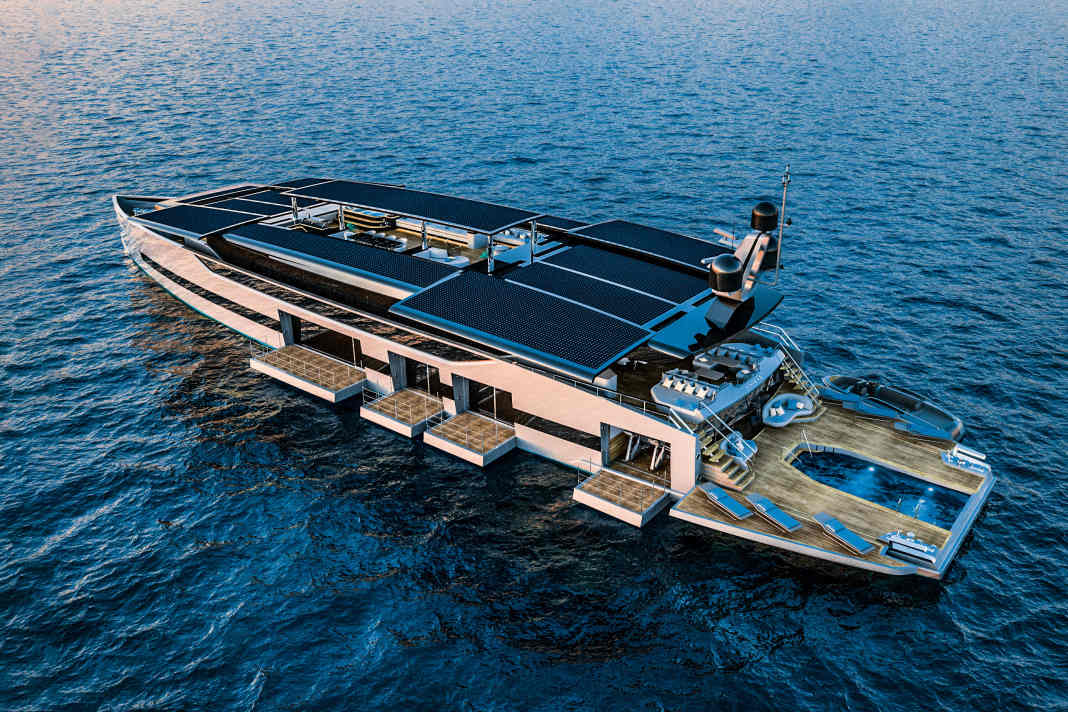





Itama as a door opener
Gianni Zuccon recognised that Casali was ahead of his time and hired him five days after he graduated summa cum laude. "I spent six years at Zuccon and learnt about the processes in a studio and how yacht design really works." He opened his own studio in 2004 with one employee, now there are eleven. Their first major commission: Itama. When the shipyard, founded in 1969, became part of the Ferretti Group in 2004, they were looking for a new designer. There was a lot of interest and the brand had a lot of appeal. But Casali had an advocate in Pershing founder Tilli Antonelli: "Tilli told Norberto Ferretti that he should also consider me as a young designer. So he did and presented me with my first big challenge."
By 2010, Marco Casali had created seven models ranging from 40 to 75 feet, always travelling at around 40 knots and always designed as open boats, i.e. with a deck that is as unobstructed as possible. Instead of a superstructure, the flat windscreen, which extends all the way to the stern, appears to emerge from the long foredeck as if from a single mould via the rounded coaming. Another characteristic feature extends across the deep V of the underwater hull: the "spoon bow", which can be seen from above in the front third as the widest part of the deck. Although this reduces the planing resistance and cw value, it deflects water from below to the sides, far away from the often snow-white decks. The current Itama portfolio includes three Casali models, which continue to run almost unchanged and sell very well. "Around twelve are built each year. Just yesterday, a friend called me who wanted a new 62. I enquired and was told that they wouldn't be able to start for another year."
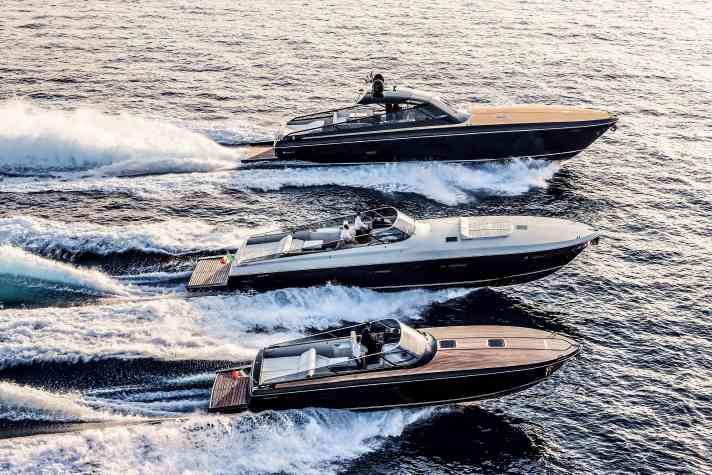
Marco Casali yachts work in all conditions
When the Italian talks about his Itamas, he emphasises one point: seaworthiness. It is important to him that owners can use their yacht in any conditions, as he does himself with his Pershing 54, mostly between Corsica and Sardinia. Why doesn't he sail an Itama? "In good condition, it's almost impossible to get hold of one on the second-hand market. And if you do, at horrendous prices." Itama has one of the longest-running yacht lines. "When the first 62 came onto the market, the interiors were still dominated by cherry wood," says Casali, who is still passionate about the brand. "I presented a walkaround version of the 38 back in 2006, which would certainly have sold well but was never realised. I hope that one day a designer will take on the brand." Casali maintained his independence during the Itama period and took on other commissions with his studio. He designed villas and also catamarans again.
However, the twin-hulls did not just return to his life with Silent Yachts: "Aldabra was my second client. They built luxurious sailing cats and unfortunately disappeared from the market, although they foresaw the current trend 15 years ago." In 2005, one model already featured solar panels on the roof. "Before I joined Silent Yachts, I worked for a start-up that wanted to build a charter fleet of solar catamarans." Casali came into contact with the solar cat manufacturer from Austria through friends of the shipyard owners when Silent was looking for a designer for the 80. Once again, he was not faced with an easy task: "The solar modules take up a flat, boring surface that needs to be integrated well into the design." The flybridge thus emerges from a homogeneous photovoltaic surface, with a hardtop rising up to expose the steering position below. Michael Köhler and his team have already received nine orders for the 24 metre long E-cat, which is also available as a three-decker and is built in both Italy and Thailand.
The Silent 100 Explorer takes the "transformer" principle of fanned-out solar modules to the extreme, with its top deck modules exposing a helipad. At 31 metres long, 13.62 metres wide and 10.46 metres high, the interior and exterior surfaces of the 440 gross tonne cat correspond to a 40 to 50 metre long monohull. The owner should be able to harvest up to 40 kilowatts of solar energy at peak times for the first time in 2023.
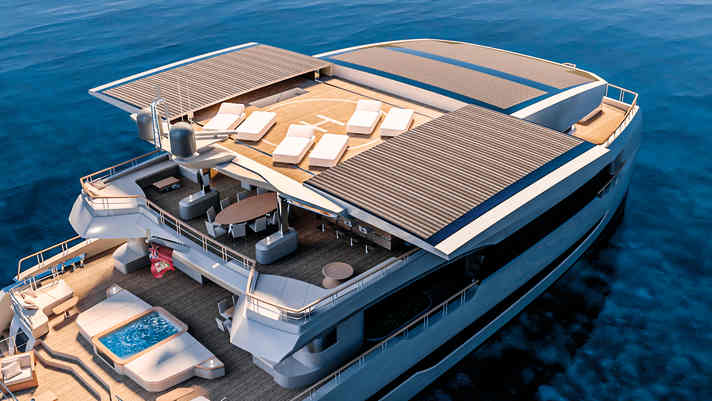
High speed and sustainability
The question arises as to what extent its power formats are at odds with the solar concepts. After all, the 30 metre long ISA Supersportivo GTO 100 "Aldabra" shoots across the Mediterranean at speeds of up to 55 knots. Casali prefers a diplomatic answer: "The joy of travelling fast is in human nature. At sea, it's not about top speed, but about being able to maintain the highest possible speed in all sea conditions." In the same breath, the Roman architect points out that he does not come up with futuristic concepts that stand out but do not work in rough seas. Casali opens up a meta-level: "I want to get as many people on the water as possible. That's why I also work for Bavaria and am interested in everything that floats."
Casali describes the 50-metre "Lady" project, which is being built at Columbus Yachts in Genoa and will be shown at this year's Monaco Yacht Show, as the exact opposite of his high-speed projects. "We tried it all-electric, but it has become a modern hybrid drive. She is very ecologically orientated," says Casali about the owner, who also placed the interior design in Casali's hands and subordinated it to an ecological focus. Green materials are used, for which no animals had to die, and which are sourced as locally as possible. The building, which is less than 500 gross tonnes in size, has a stern pool, a helipad on the foredeck and a complex air purification system that breaks down pollutants with the help of cold plasma. Her designer promises: "Not only will the lines be timeless and feminine, the colour scheme will also be surprising."
How to address the new generation of owners
Too Design's customer base also includes comparatively young people. They want to stay on board for longer because the world of work has changed. "In the industry, we are dealing with 27-year-old owners who have made their money with bitcoins and are getting on board at 50 metres." He has some of these customers, and they often seek initial contact via Instagram. One young owner was close to finalising his deal, two others were successful. They came via a broker and owner's representative. Casali later learnt that the owners had previously discovered him on Instagram.
Millennial acquisition has recently been made easier for the Roman design address by NFTs. The first virtual works of art, a Star Wars and a Miami Vice yacht, were presented at the Miami Boat Show, together with the NFT platform Cloudyachts.co. A real concept dedicated to sustainability is called "VisionE" - which can also be read as the future in Italian. "It aims to show that fully electric monohulls are also possible, even though they require more propulsion energy than catamarans." The characteristics: two decks, just under 500 gross tonnes, an efficient hull in the shape of a sailing yacht and all cabins in the hull, but each equipped with its own folding balcony. This is important for the new generation of owners who want to spend a lot of time outside. As with the Silent models, the solar panels on the roof extend upwards and to the side, revealing further rows of panels underneath. The almost 57 metre long aluminium structure is powered by fuel cells or diesel generators.
Through friends, Casali came to design an e-bike that attracted a great deal of attention and whose prototype he is very happy to show interested parties on his mobile phone. The eye-catcher is currently under construction and has brought him design commissions for other, far more traditional bikes. At the moment, global supply bottlenecks are slowing down production of the first 500 super pedelecs. When the Evero Bike is available, it will accelerate to 80 kilometres per hour - making it slightly faster than the 40-knot Itamas with their diesel engines. But it won't be long before even large gliders on the water are fully electrified. And it is certain that Marco Casali will then be involved in the design.
